Author: Dean Heckscher
Cooking in an oven should be a breeze. Most oven dishes need only minimum attention, leaving you time to get on with life. But despite carefully written recipes, ideal cooking temperatures can vary, depending on what type of oven you own. And then you have to consider which setting to use, especially if you’ve a fan-forced oven.
Whether you’re a novice or a budding Master Chef, choosing the right oven temperature can be a tricky choice. And the last thing you want is undercooked or burnt food. So to help you find the right oven temperature for your next gastronomic creation, here’s Canstar Blue’s handy oven temperature guide.
Right Oven Temperature Guide. In this article we cover:
- The 3 basic temperatures
- Vegetables
- Pork
- Turkey
- Chicken
- Beef
- Lamb
- Oven thermometer method
- Fan-forced vs conventional oven
The 3 basic temperatures:
- Low oven: A low oven of 120-150°C is good for long, slow roasting, especially for tenderising tough cuts of meat. A low oven is ideal for many meals with high-protein ingredients, like meat or eggs, which end up tough and chewy if you overcook them.
- Medium oven: A medium oven is heated to 180°C. This is a good baseline temperature for everything from cakes and pasta bakes to apple pies. If you’re not sure what temperature you need, or how long to cook a dish, set it to 180°C and keep an eye on it.
- High oven: Heated to 200-230°C, a high oven is great for roasting lean cuts of meat and fish quickly
Read on for the specifics:
Oven temperatures for cooking
Vegetables
It wouldn’t be a roast dinner without a side of roast veggies. And oven-baked vegetables are a good way to get your 5-a-day, either hot on a cold winter’s day, or in a summer salad. Plenty of vegetables are fine to go in the oven. Although different veggies require different cooking times.
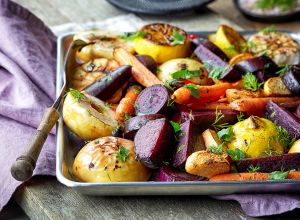
For traditional roast veggies – such as carrots, onions, potatoes and pumpkin – cooking times generally fall between 30-45mins at 220°C.
Other popular veggies, including zucchini and capsicums, take between 10-20mins at the same temperature, as do green beans and asparagus.
Cooking times will vary depending on your oven model and type, and how well done you prefer your vegetables. Of course, no one likes their veggies burnt to a crisp, so always keep an eye on your oven, regardless of what’s cooking.
Meats
Roast pork
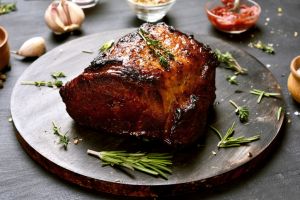
Roast pork, especially pork crackling, is a fan favourite. How you cook it depends on your cut of pork and how you like your meat: either slightly pink and juicy, or well-done.
For a leg of pork with rind, start with an oven temperature of 220°C, before dropping to 180°C for the second half of the cook.
The weight of your cut also affects its cook time. As a general rule, for pork, allow 15-20mins per 500g of meat. Although the rind crackling is a good indication that the temperature is ready to be dropped.
Other pork roasts, such as pork loin, pork rack or pork scotch fillet, generally take longer to cook than pork leg. So always keep an eye on what you’re cooking to ensure you’re left with a succulent pork roast.
Roast turkey
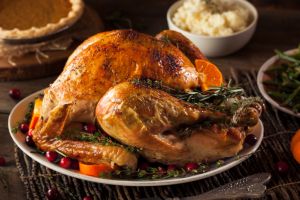
Cooking times will vary depending on the size of the turkey, and whether it’s been stuffed. Birds up to 4kg should be cooked for 90mins, plus an extra 70mins per kilo. For larger turkeys: cook for 90mins, plus 20mins extra per kilo.
Turkey can be cooked at 180°C. Although for larger turkeys dropping the temperature to 160°C can help balance out the longer cooking time, to ensure you’re not left with overcooked skin.
If you’re roasting just a turkey breast, and not the whole bird, ramp up the temperature to 200°C and cook for 30mins per kilo of meat.
Roast chicken
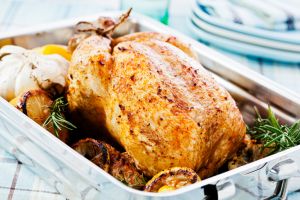
In an 180°C oven, cook the chicken for 25mins, before lowering the temperature to 165°C and cooking for another 45-60mins, depending on the size of the chicken. To be extra sure that your chicken is cooked to perfection, a food thermometer is a handy tool. A reading of 65-70°C indicates that the chicken is ready to be served.
- Always ensure your chicken is thoroughly cooked through. Juices should run clear and not pink.
Roast beef
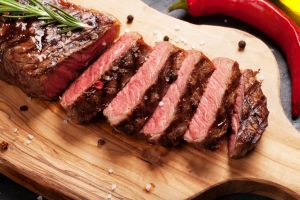
There are plenty of options when cooking beef, and personal preference is a big factor.
For rib-eye, rump, sirloin, fillet and rib roast, a 200°C oven will get the job done. Those who like their meat rare will only have to wait 15-30mins. Medium lovers will have to wait an extra 5mins, and those preferring their beef well done between 25-30mins.
For beef silverside, blade, round, topside, eye round or oyster blade beef, drop the temperature to 160°C and cook for 20-25mins for rare, 25-30mins for medium, and 30-35mins for well done.
- It’s always best to keep an eye on your beef while it’s in the oven to ensure it doesn’t overcook. Before serving, cover it with foil and let it rest thoroughly
Roast lamb
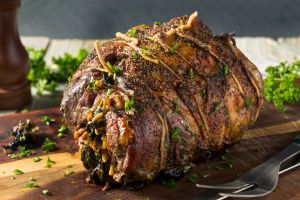
Similar to roasting beef, cooking a lamb roast depends not only on which part you’re cooking, but your personal preference as to the meat. Topside roasts and lamb rumps need a 220°C oven for 15-20mins for rare, 20-25mins for medium and 25-30mins for well done.
Rack of lamb or a crown roast requires a slightly lower temperature, 200°C, and 20-25mins for rare, or up to 45mins for well done. If you’re cooking loin, leg or shoulder, you’ll only need to preheat an oven to 180°C. Cook times vary between 20-35mins depending on your preferences.
Oven thermometer method
An oven thermometer is handy way of checking your meat has hit its required cooking temperature. For poultry, insert the thermometer into the inner thigh near the breast for the most accurate reading. For red meat, such as beef, pork and lamb, the thermometer should be inserted into the centre of the thickest part, away from bone, fat and gristle. Here are the idea temperatures for perfect meat:
| Food Type | Temperature |
| Fish | 63oC |
| Mince & Sausages | 71oC |
| Chicken & Turkey | 74oC |
| Beef, Lamb & Veal | |
| Medium Rate | 63oC |
| Medium | 71oC |
| Well Done | 77oC |
| Pork | |
| Medium | 71oC |
| Well Done | 77oC |
| Crackling | 70-75oC |
Which oven is the best for baking?
The results you achieve baking and roasting will depend greatly on your style and make of oven. Because all ovens are build differently, results are often not consistent, even if the same recipe is followed. That’s why it’s important to get to know your oven and how it cooks.
It’s also important to note that cook times and temperatures will vary the more you cram into your oven. If you’ve meat and veggies roasting at the same time, you’ll need to tweak your temperatures, as your oven will need to work harder. Opening and closing the door too often and letting the heat out will also lead to longer cook times.
Fan force vs conventional cooking
Conventional oven cooking
![]()
It takes two to tango when you’re dancing with both the upper and lower heating elements of an oven. You might recognise this setting as conventional, static or traditional heating – otherwise known as the option that isn’t fan-forced.
The lines featured on the symbol indicate the position of the heating elements. So, an icon with only one line at the top (or bottom) only contains the top, or lower, heating element. This mode best caters towards bakers, because it doesn’t utilise an oven’s fan, allowing the heat to travel naturally to the centre of the oven. This is why conventional oven cooking works best when the dish is placed in the centre of any bottom shelf.
- Conventional oven cooking is useful for slow-cooked foods, such as stews or bread, as well as fatty meats, like duck or goose. It’s also suitable for baking puddings and heavier cakes.
Fan-forced
![]()
Is your cake fluffy at the base but darkened to a crisp on top? The fan-forced mode can help you achieve greater consistency throughout, because the top and lower elements are not active. Instead, the setting turns on a fan and heating element, which distribute hot air throughout the oven. This creates instant heat, shortening cooking times and lowering energy consumption.
Some oven brands boast side-venting technology, which prevents different odours and flavours from mingling. But the fan-forced function means air is constantly moving, so the fan-forced setting should naturally minimise any mixing of flavours and odours. Keep in mind that compared to cooking in conventional ovens, fan-forced temperatures should be around 20°C lower.
- Fan-forced cooking is suitable for preparing large family dinners, such as roast meats, that need to be tender and succulent on the inside, but well done on the outside. Plus, the function works well when cooking a variety of foods in the oven at the same time.
Ovens can churn through power. And where electricity use is concerned, it always pays to check whether you’re getting the best deal. If you know you regularly use your oven at certain times of the day, why not swap to a provider that offers a free hour of power each day? Your savings could be considerable. To make choosing the best electricity provider easier, Canstar compares them on value and service.
Canstar Blue’s latest review of NZ power companies compares them on customer satisfaction. The table below is an abridged version of our full results, available here.
^ By clicking on a brand or 'details' button, you will leave Canstar Blue and be taken to either a product provider website or a Canstar Blue NZ brand page. You agree that Canstar Blue NZ’s terms and conditions apply (without limitation) to your use of this service,to any referral to a product provider from our website, and any transaction that follows. Canstar Blue may earn a fee for referrals from its website tables, and from sponsorship (advertising) of certain products. Payment of sponsorship fees does not influence the star rating that Canstar Blue awards to a sponsored product. Fees payable by product providers for referrals and sponsorship may vary between providers, website position, and revenue model. Sponsorship fees may be higher than referral fees. Sponsored products are clearly disclosed as such on website pages. They may appear in a number of areas of the website such as in comparison tables, on hub pages and in articles. Sponsored products may be displayed in a fixed position in a table, regardless of the product’s rating, price or other attributes. The table position of a sponsored product does not indicate any ranking, rating or endorsement by Canstar Blue. See How we are funded for further details.
Canstar Blue NZ Research finalised in April 2023, published in June 2023.
See Our Ratings Methodology
Enjoy reading this article?
You can like us on Facebook and get social, or sign up to receive more news like this straight to your inbox.
By subscribing you agree to the Canstar Privacy Policy


Share this article